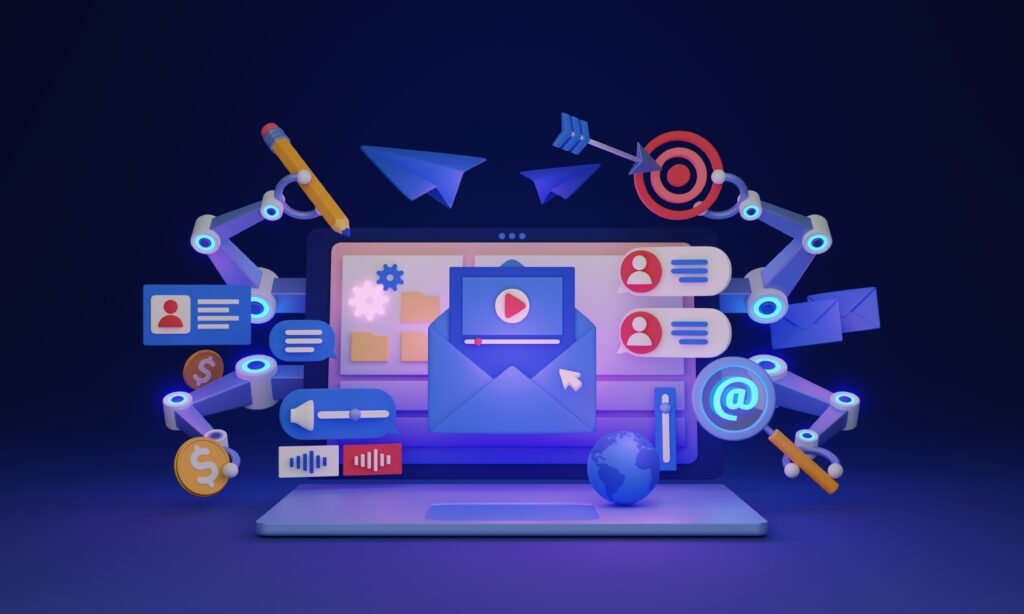Social media management has evolved. What used to be a task of scheduling a few weekly posts is now a full-time, multi-faceted responsibility.
Brands and creators are expected to produce content across multiple platforms, respond to messages in real time, adapt to trends, and measure performance daily.
This increasing complexity has made one thing clear: manual social media management is no longer sustainable. That’s where artificial intelligence (AI) steps in.
Once limited to large enterprises, AI is now integrated into everyday marketing tools, empowering even solo creators and small businesses to manage their social media efficiently.
In this blog, we’ll explore the growing role of AI in social media management, the tools enabling this transformation, and how to use AI to save time, boost engagement, and scale results without losing your brand’s voice.
What Is AI in Social Media Management?
AI in social media refers to the use of machine learning powered tools that can understand, create, analyze, or optimize social media content and engagement.
These tools are capable of automating repetitive tasks, recognizing trends, and making real-time adjustments based on data.
You may already be using AI features without even knowing it:
- Instagram suggesting hashtags
- Facebook recommending post times
- Chatbots responding instantly to common customer questions
- Design tools recommending layouts based on your previous choices
AI enables you to do more, faster, without hiring an entire team. It assists rather than replaces, and when used wisely, it enhances both the consistency and creativity of your social media presence.
Key Areas Where AI Is Making a Difference
Here are the most impactful areas where AI is transforming social media management.
1. Content Creation and Copywriting
Writing social posts across multiple platforms daily is time-consuming. AI writing tools like Jasper, ChatGPT, Copy.ai, and Writesonic help generate ideas, write captions, suggest hashtags, and even produce blog summaries or newsletter intros.
Examples of how creators and businesses are using AI for content:
- Generating multiple versions of one caption for A/B testing
- Creating full Instagram or LinkedIn post series in minutes
- Drafting engaging replies to customer comments
These tools are trained on high-performing content, which means you’re not starting from scratch. You still need to review and refine the content to match your tone, but the heavy lifting is done.
2. Scheduling and Publishing Content
AI-enhanced scheduling tools like Buffer, Later, Metricool, and Hootsuite offer more than just calendar views. They use data to suggest the best posting times based on your audience’s engagement patterns.
Benefits include:
- Consistent posting without logging in daily
- Automatic rescheduling of evergreen content
- Time zone optimization across global audiences
AI helps keep your content active even when you’re offline or busy with other tasks.
3. Visual and Video Content Creation
Designing content is one of the most resource-intensive parts of social media. AI-driven tools like Canva’s Magic Design, Adobe Express, Lumen5, and Pictory allow even non-designers to create professional visuals and short-form videos quickly.
With AI, you can:
- Turn blog posts into short videos or carousels
- Use text-to-image generators to create visual posts
- Generate design suggestions based on your brand assets
These tools significantly reduce design turnaround time and remove the need for expensive creative software or freelance designers.
4. Analytics and Sentiment Analysis
Knowing what content works and why is essential. AI-powered analytics tools such as Sprout Social, Brand24, and Hootsuite Insights can analyze not only performance metrics like reach and engagement but also sentiment—how your audience feels about your posts.
AI tools can:
- Identify positive, neutral, or negative sentiments in comments
- Suggest content improvements based on past performance
- Spot unusual spikes in engagement that may indicate trends or crises
This turns guesswork into strategy, enabling better decision-making based on real user behavior.
5. Chatbots and Automated Responses
Today’s social media includes direct interactions through DMs, comments, and customer service channels. AI chatbots like ManyChat, Tidio, MobileMonkey, and Drift help automate common responses and qualify leads through conversational flows.
Use cases:
- Instant replies to FAQs
- Appointment or call bookings through Messenger or Instagram
- Lead capture through interactive question flows
Modern chatbots use natural language processing (NLP) to understand and respond to user queries conversationally, making customer experience faster and smoother.
6. Trend Monitoring and Competitive Analysis
AI tools can scan vast amounts of online content to detect rising trends, relevant keywords, or competitor activity in real time.
Tools like BuzzSumo, Feedly, Exploding Topics, and Mention help you:
- Discover what topics are gaining traction in your industry
- Monitor competitor posts and performance
- Identify opportunities for timely content
This helps you stay relevant and capitalize on trending conversations before they peak.
Benefits of Using AI in Social Media
Adopting AI in your social media workflow provides several significant advantages:
Time Efficiency
AI handles repetitive tasks like caption writing, post scheduling, and data tracking, giving you more time to focus on strategy and creative direction.
Consistency
Posting consistently across platforms is easier with automated tools, ensuring your brand stays visible and top-of-mind for followers.
Improved Performance
AI analyzes historical engagement and audience behavior to help you post the right content, at the right time, in the right format.
Scalability
Whether you’re managing two accounts or twenty, AI enables you to scale operations without needing a larger team.
Personalized Engagement
AI chatbots and recommendation engines enable more tailored user interactions based on real-time data, improving customer experience.
Real-World Examples of AI in Action
Here are a few practical examples of how businesses and creators are benefiting from AI in social media:
A Marketing Agency Automating Client Workflows
An agency managing 15 client accounts used Lately.ai to repurpose long-form content into short social posts, saving 20+ hours per week on copywriting.
A Solo Creator Scaling Content Output
A content creator used ChatGPT and Buffer to generate weekly content calendars, write captions, and auto-schedule posts across Twitter, LinkedIn, and Instagram. Result: double the output with half the effort.
A Small Retail Business Using Chatbots
A boutique gift shop implemented ManyChat on Facebook Messenger to answer customer questions instantly, resulting in a 30 percent increase in conversion from chat to purchase.
Challenges and Ethical Considerations
While AI provides many benefits, there are also a few challenges and concerns to consider:
Lack of Authenticity
AI-generated content can sometimes feel generic. Always review and customize content before publishing.
Over-Reliance on Automation
Automating everything may reduce genuine interaction. Balance is key—automate tasks, not relationships.
Risk of Inaccurate Responses
Chatbots may misunderstand nuanced customer inquiries. Regularly test and update your chatbot flows.
Data Privacy
Some tools may collect sensitive information. Ensure the tools you use comply with privacy regulations and best practices.
Getting Started: Tools to Try
If you’re ready to explore AI in your social media workflow, start with one or two of these tools:
| Purpose | Recommended Tools |
| Caption Writing | ChatGPT, Jasper, Copy.ai |
| Scheduling & Publishing | Buffer, Later, Metricool |
| Visual Content Creation | Canva AI, Adobe Express, Pictory |
| Chatbot Automation | ManyChat, Tidio |
| Referral & Affiliate Marketing | ReferralCandy |
| Analytics and Sentiment | Sprout Social, Brand24 |
| Trend Monitoring | BuzzSumo, Feedly |
Many of these offer free trials or plans to help you get started without major investment.
Conclusion: Smarter Social Media Management
AI isn’t a replacement for marketers, it’s a support system. It allows you to maintain consistency, make informed decisions, and focus more on creativity and connection.
Whether you’re a solo entrepreneur, part of a growing team, or managing multiple brands, AI can give you the tools to scale your efforts without losing your voice.
Start small. Automate one task. Experiment with one tool. From there, build a system that works for you and your audience.
Because in the fast-moving world of social media, staying relevant means staying efficient—and AI helps you do both.



